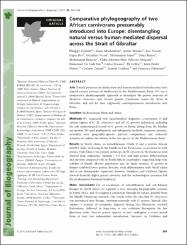Comparative phylogeography of two African carnivorans presumably introduced into Europe: disentangling natural versus human-mediated dispersal across the Strait of Gibraltar

View/
Access
info:eu-repo/semantics/closedAccessDate
2011Author
Gaubert, PhilippeMachordom, Annie
Morales, Arturo
Vicente Lopez-Bao, Jose
Veron, Geraldine
Amin, Mohammad
Barros, Tania
Metadata
Show full item recordAbstract
Aim Natural processes of colonization and human-mediated introductions have shaped current patterns of biodiversity in the Mediterranean Basin. We use a comparative phylogeographic approach to investigate the genetic structure of Herpestes ichneumon and Genetta genetta (Carnivora) across the Strait of Gibraltar, and test for their supposedly contemporaneous introduction into Iberia. Location Mediterranean Basin and Africa. Methods We sequenced two mitochondrial fragments (cytochrome b and control region) of 91 (H. ichneumon) and 185 (G. genetta) individuals, including the sole archaeological record of G. genetta in Iberia, dating from the Muslim occupation. We used phylogenetic and tokogenetic methods, summary statistics, neutrality tests, geographic-genetic pairwise comparisons and coalescent estimates to explore the history of the two species in the Mediterranean Basin. Results In North Africa, an autochthonous (Clade I) and a western African mtDNA clade, coalescing in the Middle to Late Pleistocene, co-occurred in both species. Only Clade I was present in Europe. In H. ichneumon, the European pool showed deep coalescence (median = 335 kyr) and high genetic differentiation and diversity compared with its North African counterpart, suggesting long-term stability of female effective population size. In sharp contrast, G. genetta in Europe exhibited lower genetic diversity, weak differentiation with North Africa and recent demographic expansion; however, Andalusia and Catalonia (Spain) showed distinctly higher genetic diversity, and the archaeological specimen had the predominant European haplotype. Main conclusions The co-occurrence of autochthonous and sub-Saharan lineages in North Africa (1) supports a new, emerging biogeographic scenario in North Africa, and (2) suggests a connection through the Sahara, possibly from the Middle Pleistocene onwards. Our results refute the idea that H. ichneumon was introduced into Europe contemporaneously with G. genetta. Instead, they support a scenario of sweepstake dispersal during Late Pleistocene sea-level fluctuations, followed by long-term in situ evolution throughout the last glaciation cycles. Genetta genetta appears to have undergone a recent spread from at least two independent introduction 'hotspots' in Catalonia and Andalusia, possibly following antique trade routes and/or Muslim invasions. Despite their contrasting histories, the European gene pools of both species represent unusual cases leading to the preservation of autochthonous, North African lineages.

















